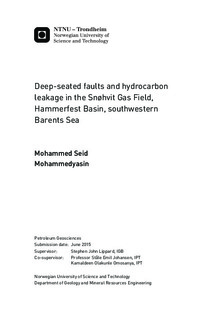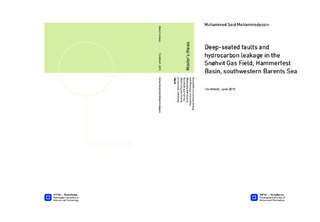| dc.contributor.advisor | Lippard, Stephen John | |
| dc.contributor.advisor | Johansen, Professor Ståle Emil | |
| dc.contributor.advisor | Omosanya, Kamaldeen Olakunle | |
| dc.contributor.author | Mohammedyasin, Mohammed Seid | |
| dc.date.accessioned | 2015-10-05T14:56:32Z | |
| dc.date.available | 2015-10-05T14:56:32Z | |
| dc.date.created | 2015-06-20 | |
| dc.date.issued | 2015 | |
| dc.identifier | ntnudaim:12604 | |
| dc.identifier.uri | http://hdl.handle.net/11250/2350423 | |
| dc.description.abstract | Abstract
High-quality 3D seismic data are used to analyze the history of fault growth and hydrocarbon leakage in the Snøhvit Field, southwestern Barents Sea. The aim of this work is to evaluate role of tectonic fracturing as a mechanism driving fluid-flow in the study area. To achieve this aim, an integrated approach including seismic interpretation, multiple seismic attribute analysis, fault modeling and displacement analysis was used.
The six major faults in the study area are dip-slip normal faults which are characterized by complex lateral and vertical segmentation. The three main episodes of fault reactivation interpreted were in Upper Jurassic (Kimmeridgian), Lower Cretaceous and Paleocene times. Fault reactivation in the study area is mainly through dip-linkage. Throw-distance plots of the representative faults also revealed along-strike linkage and multi-skewed C-type profiles. The throw profiles show that faults in the study area evolved through polycyclic activity involving both blind propagation, syn-sedimentary activity and that they have their maximum displacement at the reservoir zone. The expansion and growth indices provide evidence for coeval fault activity with sedimentation and interaction of the faults with a free surface during their evolution.
Hydrocarbon-related high-amplitude anomalies in the study area have negative amplitude, reverse polarity and are unconformable with structural reflectors. The interpreted fluid accumulations are spatially located at the upper tips of the major faults and gas chimneys. Four episodes of fluid migration in the study area are linked to periods of fault reactivation and Neogene glaciations. Fluid leakage is driven by tectonic fracturing, uplift and erosion. The interpreted deep-seated faults are the main conduits for shallow fluid accumulations in the Snøhvit Field. | |
| dc.language | eng | |
| dc.publisher | NTNU | |
| dc.subject | Petroleum Geosciences, Petroleum Geology | |
| dc.title | Deep-seated faults and hydrocarbon leakage in the Snøhvit Gas Field, Hammerfest Basin, southwestern Barents Sea | |
| dc.type | Master thesis | |
| dc.source.pagenumber | 119 | |

